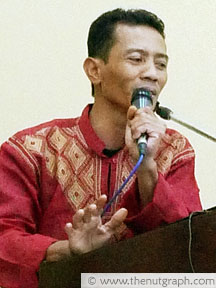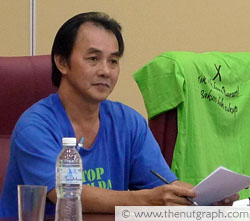by Gan Pei Ling
| The Nut Graph
MOST of us living in Peninsular Malaysia take electricity for granted as we have hardly experienced a blackout since the 1990s. But how many of us have stopped for a moment to think where the electricity, that allows us to turn on our TVs and computers, comes from?
What are the impacts of the power plants that generate our electricity — be they coal, hydropower and perhaps in the future, nuclear — on the environment and local communities living near these plants?
Coal plant and fishes
 At a climate and energy forum in Universiti Malaya in Kuala Lumpur on
8 and 9 Oct 2011, Peninsular Inshore Fishermen Action Network president
Jamaluddin Mohamad, from Johor, talked about the impact of the Tanjung
Bin coal plant.
At a climate and energy forum in Universiti Malaya in Kuala Lumpur on
8 and 9 Oct 2011, Peninsular Inshore Fishermen Action Network president
Jamaluddin Mohamad, from Johor, talked about the impact of the Tanjung
Bin coal plant.
“They are using chlorine to prevent sea water from corroding the pipes in their power plant. But it is polluting the ocean, and the water that they use to cool the plant is being released back to the sea in high temperature. Our catch has been dwindling over the years,” Jamaluddin told the forum that was jointly organised by Third World Network, Consumers Association of Penang and Sahabat Alam Malaysia.
Run by independent power producer Malakoff Corp Bhd, the 2,100MW Tanjung Bin coal plant was built in 2003. The power producer intends to expand the plant’s capacity by another 1,000MW.
Jamaluddin noted that Tanjung Bin was rapidly developing into an industrial area: “The areas where we can fish are shrinking and becoming increasingly limited.”
He said none of the affected communities are against “development” but the coal plant and rapid industrial development are threatening their livelihoods: “That’s why we’re protesting against the coal plant’s expansion.”
Dams and livelihoods
Across the South China Sea, natives in Sarawak have been displaced by the Bakun dam and more will be displaced by 12 dams the state government is planning to build to boost its power capacity to 7,000MW, over 600% of its 2008 capacity.
 Philip Jau, a Kayan from the Baram valley, said 20,000 people from
various communities will be displaced by the Baram dam the Sarawak
government intends to build. “This does not include those who are living
downstream yet. Up to 38,900 hectares of our native customary land will
be submerged. Our land is our life. We cannot live without it. It is as
simple as that,” said Philip.
Philip Jau, a Kayan from the Baram valley, said 20,000 people from
various communities will be displaced by the Baram dam the Sarawak
government intends to build. “This does not include those who are living
downstream yet. Up to 38,900 hectares of our native customary land will
be submerged. Our land is our life. We cannot live without it. It is as
simple as that,” said Philip.
The Baram dam will also cause deforestation and biodiversity loss.
Philip said the communities affected by these dams are establishing a network to create a united movement against what he described as the “damned” dams. “We want electricity but we hope the government will explore other alternatives like micro-hydro, which is more environmentally-friendly, though it may not generate as much profit as building a mega dam,” he said.
Philip said he has been to the Sungai Asap settlement where the affected communities from Bakun were relocated to. “They’re suffering. Most of the villagers feel that they have no future,” said Philip. The communities in Baram do not want to suffer the same fate with good reason.
Of broken promises
The Bakun dam flooded 69,000 hectares of land, around the size of Singapore, and forced the relocation of 10,000 people. Construction began in 1996 and the project eventually cost RM7.5bil.
 Wing Mikiu from the Sungai Asap
settlement told the forum the Sarawak government only allocated three
acres of land to each family that were relocated from Bakun in 1999. “My
family has eight children. Three acres of land is not enough for us.
We’ve 2,000 new couples in our settlement to date and most of them have
no land [to cultivate],” said Wing.
Wing Mikiu from the Sungai Asap
settlement told the forum the Sarawak government only allocated three
acres of land to each family that were relocated from Bakun in 1999. “My
family has eight children. Three acres of land is not enough for us.
We’ve 2,000 new couples in our settlement to date and most of them have
no land [to cultivate],” said Wing.
He said the government promised to build the villagers a new town with an airport, jetty, highway and even an international school in the effort to persuade villagers to leave their ancestral homes. But today, many youths have moved to Bintulu or other towns due to the lack of job opportunities in Sungai Asap.
To add insult to injury, Wing said the compensation villagers received for their now submerged native customary lands range from RM0.30 to RM3 million. “If you’re unhappy with the amount, you can bring it to court or complain to the district office, but you’ll have to pay for the cost to resurvey the land yourself,” Wing explained.
“Perhaps the project profited the company and the people in this state [when the dam starts producing energy], but what about us? Our people didn’t enjoy any development as promised, and we’ve lost our land and heritage,” said Wing.
Source of inspiration
Protesting against a coal plant or dam may seem daunting, but local communities can look to Green Surf for inspiration. Since 2007, the coalition has successfully pressured the government three times to cancel plans to build a coal plant in Sabah.
 Wong Tack from the Sabah Environmental Protection Society, which is
one of the five environmental organisations in Green Surf, said it was
most important for communities to be united. “Locals must take
responsibility. If the people are united [in the struggle], then we can
solve any problem,” said Wong.
Wong Tack from the Sabah Environmental Protection Society, which is
one of the five environmental organisations in Green Surf, said it was
most important for communities to be united. “Locals must take
responsibility. If the people are united [in the struggle], then we can
solve any problem,” said Wong.
Wong pointed out that it is also crucial to build partnerships with national and international partners. “When the government proposed to build the coal plant for the third time (in Kampung Sinakut in 2009), we knew this could no longer be a Sabah issue. We had to turn it into an international issue.
“We went to the Parliament and built partnerships with international NGOs (non-governmental organisations) so that the government would have to listen to us, and finally they did,” said Wong. The government scrapped the plan to build a coal plant in Sabah for good in February 2011.
Development? Where?
Those with vested interests in mega projects have a tendency to demonise local communities and environmentalists who oppose such projects as “anti-development”.
But if there’s anything to learn from the stories of community leaders, it is not just about conserving the environment. It is about defending communities’ source of livelihood and preferred way of life so that they can continue to feed, clothe and shelter themselves, and continue to work and fend for their families.
Of course, the government and corporations involved can continue to ignore local communities’ interests and voices. But surely, they do so at their peril? If communities are adversely affected economically by development projects, surely these communities would have nothing else to lose in fighting back.
MOST of us living in Peninsular Malaysia take electricity for granted as we have hardly experienced a blackout since the 1990s. But how many of us have stopped for a moment to think where the electricity, that allows us to turn on our TVs and computers, comes from?
What are the impacts of the power plants that generate our electricity — be they coal, hydropower and perhaps in the future, nuclear — on the environment and local communities living near these plants?
Coal plant and fishes

Jamaluddin
“They are using chlorine to prevent sea water from corroding the pipes in their power plant. But it is polluting the ocean, and the water that they use to cool the plant is being released back to the sea in high temperature. Our catch has been dwindling over the years,” Jamaluddin told the forum that was jointly organised by Third World Network, Consumers Association of Penang and Sahabat Alam Malaysia.
Run by independent power producer Malakoff Corp Bhd, the 2,100MW Tanjung Bin coal plant was built in 2003. The power producer intends to expand the plant’s capacity by another 1,000MW.
Jamaluddin noted that Tanjung Bin was rapidly developing into an industrial area: “The areas where we can fish are shrinking and becoming increasingly limited.”
He said none of the affected communities are against “development” but the coal plant and rapid industrial development are threatening their livelihoods: “That’s why we’re protesting against the coal plant’s expansion.”
Dams and livelihoods
Across the South China Sea, natives in Sarawak have been displaced by the Bakun dam and more will be displaced by 12 dams the state government is planning to build to boost its power capacity to 7,000MW, over 600% of its 2008 capacity.

Philip Jau
The Baram dam will also cause deforestation and biodiversity loss.
Philip said the communities affected by these dams are establishing a network to create a united movement against what he described as the “damned” dams. “We want electricity but we hope the government will explore other alternatives like micro-hydro, which is more environmentally-friendly, though it may not generate as much profit as building a mega dam,” he said.
Philip said he has been to the Sungai Asap settlement where the affected communities from Bakun were relocated to. “They’re suffering. Most of the villagers feel that they have no future,” said Philip. The communities in Baram do not want to suffer the same fate with good reason.
Of broken promises
The Bakun dam flooded 69,000 hectares of land, around the size of Singapore, and forced the relocation of 10,000 people. Construction began in 1996 and the project eventually cost RM7.5bil.

Wing Mikiu
He said the government promised to build the villagers a new town with an airport, jetty, highway and even an international school in the effort to persuade villagers to leave their ancestral homes. But today, many youths have moved to Bintulu or other towns due to the lack of job opportunities in Sungai Asap.
To add insult to injury, Wing said the compensation villagers received for their now submerged native customary lands range from RM0.30 to RM3 million. “If you’re unhappy with the amount, you can bring it to court or complain to the district office, but you’ll have to pay for the cost to resurvey the land yourself,” Wing explained.
“Perhaps the project profited the company and the people in this state [when the dam starts producing energy], but what about us? Our people didn’t enjoy any development as promised, and we’ve lost our land and heritage,” said Wing.
Source of inspiration
Protesting against a coal plant or dam may seem daunting, but local communities can look to Green Surf for inspiration. Since 2007, the coalition has successfully pressured the government three times to cancel plans to build a coal plant in Sabah.

Wong Tack
Wong pointed out that it is also crucial to build partnerships with national and international partners. “When the government proposed to build the coal plant for the third time (in Kampung Sinakut in 2009), we knew this could no longer be a Sabah issue. We had to turn it into an international issue.
“We went to the Parliament and built partnerships with international NGOs (non-governmental organisations) so that the government would have to listen to us, and finally they did,” said Wong. The government scrapped the plan to build a coal plant in Sabah for good in February 2011.
Development? Where?
Those with vested interests in mega projects have a tendency to demonise local communities and environmentalists who oppose such projects as “anti-development”.
But if there’s anything to learn from the stories of community leaders, it is not just about conserving the environment. It is about defending communities’ source of livelihood and preferred way of life so that they can continue to feed, clothe and shelter themselves, and continue to work and fend for their families.
Of course, the government and corporations involved can continue to ignore local communities’ interests and voices. But surely, they do so at their peril? If communities are adversely affected economically by development projects, surely these communities would have nothing else to lose in fighting back.

No comments:
Post a Comment